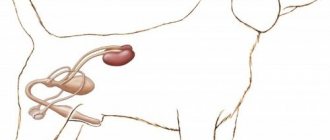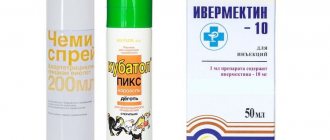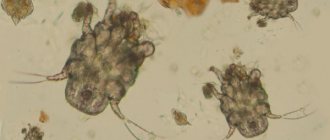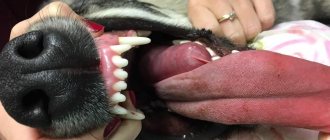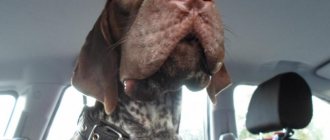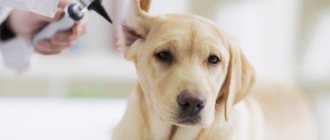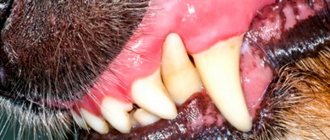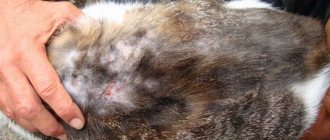Mastitis in dogs is an inflammation of the mammary gland, which often occurs after childbirth, but also occurs in nulliparous bitches, as well as in male dogs. The pathology is dangerous because it can cause blood poisoning, gangrene, benign tumor, and other problems. Therefore, if you find a lump on your animal’s chest, immediately call a doctor who will prescribe treatment for mastitis in your dog.
Causes of mastitis in dogs
The main cause of inflammation is stagnation of milk, which arose due to poor emptying of the gland during feeding (lactostasis). The problem occurs not only in females who have given birth to 2-3 puppies. It appears if the cubs are taken from the breast early or the entire litter has died. Stagnation is possible in mothers with many children who are feeding 12 babies if the babies ignored one of the nipples and the owner did not put them near the problem gland.
The alveoli that produce milk, with poor suction, expand and compress the ducts, which is why the liquid stops flowing normally. This leads to enlargement and hardening of the gland area. Stagnation is an ideal environment for bacteria. Over time, they enter the milk and begin to actively develop, causing inflammation.
The situation worsens if bacteria that cause decay (Staphylococcus aureus) penetrate into the mammary glands through injuries and microcracks. The disease progresses quickly, is acute, requires antibiotics and expensive treatment.
The fibrocystic form occurs after 6 years of age due to hormonal imbalances, and also if the bitch constantly gave birth and raised puppies. This variety can also be found in males. Fibrocystic mastitis rarely develops into a malignant tumor.
Causes
Mastitis occurs due to a number of reasons that affect the life of the animal.
In dogs that have given birth, the cause of the problem is:
- injury to the mammary gland;
- excessive production of milk, which stagnates in the glands;
- hormonal disbalance;
- genetic predisposition;
- hypothermia or overheating;
- exposure to chemicals on the gland;
- sexual infections;
- severe stress.
Weakened immunity is another reason for mastitis.
Lack of hygiene and improper care of your dog can cause illness. Often, microbes enter from dirty litter and begin to multiply in the glands, causing an inflammatory process.
Symptoms of mastitis in dogs in a female who has given birth
The sooner the owner notices the symptoms of mastitis, the higher the chances of quickly getting rid of the problem. The advanced form is difficult and expensive to treat.
What does mastitis look like in a dog at a mild stage?
When milk stagnates, a lump appears in the mammary gland. Consult your veterinarian. If the initial phase, the milk has not yet spoiled, there are no foreign impurities, it will be enough to add puppies, which will suck out the excess liquid.
Mastitis in a dog: signs of complications
If the problem is ignored, swelling appears, the lump turns red, and begins to hurt. But the presence of fever depends on the form and stage of the disease. If the pathology is not treated, the inflammation will increase. Symptoms:
- The body temperature is high, the gland is hot to the touch.
- The nipple is enlarged.
- Feeding is painful, the bitch does not allow the puppies to approach the nipples.
- Traces of pus are visible in the milk, sometimes with blood. In this case, the offspring is transferred to artificial feeding. Contaminated milk can poison the babies.
- The tumor grows, the skin turns red, becomes inflamed, and pain appears when trying to touch the tumor.
- The lymph nodes near the diseased area enlarge - round, dense lumps appear under the armpits and in the groin area.
If nothing is done, the lump softens and pus enters the bloodstream, causing infection (abscess). In parallel, gangrene develops - tissue necrosis, which must be removed surgically. Failure to treat will result in the dog's death.
Signs of the disease
In the early stages, it is quite difficult to recognize mastitis. Treatment is often started when the inflammation has become acute with severe symptoms.
Initially, the dog’s behavior changes dramatically:
- lethargy, inactivity, constant drowsiness;
- appetite decreases sharply or disappears altogether;
- there is an increase in body temperature;
- if pain is present, the nursing female stops allowing the puppies to approach her.
If you notice atypical behavior, you should examine your pet's mammary glands. Mastitis can be diagnosed by the following symptoms:
- breast hyperemia;
- redness or blueness of the mammary glands;
- seals that can be clearly felt during palpation;
- edema;
- enlarged inguinal or axillary lymph nodes;
- the presence of foreign impurities in milk (pus, mucus, blood, exudate);
- sore nipples.
Redness or blue discoloration of the mammary glands is a sign of pathology
Symptoms of mastitis in dogs with false pregnancy
If the bitch has not been bred, she may start producing milk 2 months after her heat. A couple of drops is no reason to worry. If it flows profusely, monitor the dog’s condition and palpate the chest regularly. The pet may be depressed, fever and other symptoms of inflammation will appear.
If a lump appears on the mammary gland, consult a doctor immediately. Since the main reason is a malfunction of the endocrine system, the veterinarian will prescribe hormonal, anti-inflammatory drugs.
What should you do if your dog’s mastitis recurs every time it’s falsely pregnant, and you’re not going to breed it? Spay your pet. This will not only save you from problems with inflammation of the mammary gland, but will also prevent cancer of the genital organs, pyometra (purulent inflammation of the uterus).
Treatment
Although the condition is not recognized as a disease, veterinary attention is required, especially in severe cases. False pregnancy causes psychological discomfort to the animal and can lead to diseases of the mammary glands due to stagnation of milk. For example, mastitis is possible.
Before visiting the veterinarian, try to help the animal yourself.
- You will need to switch your pet to a lower calorie diet. Reduce the amount of protein foods, eliminate dairy products. If you feed dry food, choose a lower-calorie variety (“Light”). In consultation with the doctor, decoctions of soothing herbs are given.
- If milk appears, the dog should not be allowed to suck, it is unacceptable to express - the action will become unnecessary stimulation of the mammary glands and increase milk production. If your dog frequently licks nipples and sucks milk, wear an Elizabethan collar or blanket. Try lubricating your nipples with camphor oil, alcohol or aloe juice - substances with a strong odor.
- It is necessary to take the animal for walks more often and increase physical activity. It is necessary to change the regime, the time of walks, rearrange the bowl, change the sleeping place, distracting the pet from the experienced state and creating artificial “unfavorable conditions” that help the false pregnancy pass faster.
Symptoms of fibrocystic form
The fibrocystic form is often a complication of normal mastitis that occurs in dogs after birth. But this form of mastitis can also occur in a nulliparous dog after a false pregnancy and other conditions that provoke a hormonal imbalance.
Symptoms vary:
- The tumor may be hot to the touch and granular. The formations are round in shape, mobile, and do not cause pain.
- Ichor is released from the nipple.
- The pet is clearly experiencing discomfort in the mammary glands and is trying to lick it.
- The animal refuses to eat, gets tired quickly, and behaves apathetically.
- The temperature rises, and hair falls out on the affected area.
A benign tumor can develop into oncology, so be sure to consult a doctor and get treatment.
Classification of mastitis
Inflammation can occur in two forms:
- acute – symptoms are clearly expressed, a rapidly developing process;
- chronic - symptoms may appear periodically, usually some time after estrus.
According to the nature of the flow, the following types are divided:
- serous (pathology begins in the parapapillary area, often caused by microcracks in the nipples);
- catarrhal (the ducts and milk alveoli are directly affected, developing after serous, as an ascending process);
- purulent (when bacterial microflora is involved in the process of inflammation);
- gangrenous (severe pathology when gangrene of the mammary gland may develop);
- abscess (appearance of abscesses);
- phlegmonous (spread inflammation throughout the mammary gland);
- hemorrhagic (due to numerous hemorrhages, the color of the milk takes on a bloody tint).
How to treat mastitis in a dog
Take your dog to the vet as soon as you notice a lump on the gland. After examining your pet, the doctor will tell you how to cure mastitis in a dog.
If this is not possible, the symptoms are mild (no temperature, the formation is not hot to the touch), to treat mastitis in a dog at home, you need to do the following:
- If your pet has long hair, trim it around the nipple.
- Apply puppies to the nipple where mastitis has formed in a nursing dog. Before doing this, check the quality of the milk. It should not be mixed with blood or pus. If it has inflammatory discharge (greenish color), there are white threads, transfer the offspring to artificial nutrition, call a doctor.
- Massage compacted areas after thoroughly washing your hands. When the gland softens, slowly express the milk using gentle movements. Don't try to squeeze out all the liquid. It is enough for the swelling to become softer and subside a little.
If the gland is hot, apply a cooling compress. Do not put ice directly on the skin - the animal may get burned. It’s better to make a lotion from medicinal herbs - pour 1 tbsp. sage or chamomile 1 tbsp. boiling water, leave for an hour. When the infusion has cooled, soak a gauze pad in it and apply it to the inflamed mammary gland.
Breast pump for dog
To avoid manually expressing the nutritional fluid, you can make a breast pump for your dog:
- Take a large syringe.
- Cut off the tip where the needle fits onto the syringe, making a wide hole.
- Carefully heat the cut edges so that the edge becomes smooth and does not injure the skin.
The device is pressed hermetically to the pet's nipple and milk is pumped out, after performing a massage. During the procedure, the dog can stand or lie down. There is no need to put pressure on your pet's chest in an attempt to squeeze out milk or sharply pull out the piston. You can seriously injure the dog and give it bruises.
At first it will be difficult to express, so you need to take a little, with slightly rocking movements, simulating sucking. Then the amount of expressed milk can be increased.
When to see a doctor urgently
If the dog is clearly unwell, there are signs of inflammation, it is lethargic, or has lost interest in puppies - immediately consult a veterinarian. If you live in a regional center and the nearest clinic is 30 km away, take a car and take your animal. You can also ask the doctor to come home and pay for the trip.
Call your veterinarian if:
- high temperature (more than 38.5°C);
- the affected area is hot;
- in milk - small pieces of yellow or greenish color, an incomprehensible cloudy liquid;
- long white threads stand out from the nipples;
- the lymph nodes under the arms and in the groin area have enlarged;
- purulent, inflamed areas appeared on the skin, blackness similar to bruises (a symptom of gangrene).
Veterinary care for inflammation of the mammary glands
For mastitis in dogs, treatment depends on the stage of the disease. If the situation is not critical, the doctor will prescribe medicinal ointments for mastitis for dogs, which will help relieve inflammation. The doctor prescribes the following medications to treat mastitis in dogs:
- Mastometrin - a medicine for mastitis in dogs eliminates pain and inflammation.
- Antibiotics (Ceftriaxone, Amoxicillin) – for mastitis in a bitch, they are prescribed for treatment to destroy the bacterial infection.
- Fosprenil is an immunomodulator that increases the body's resistance to disease.
- Novocaine blockades - eliminate pain.
In extreme cases, the doctor resorts to surgery - he opens the abscess, removes dead tissue, and installs a drain to drain the pus. If gangrene has occurred, he may remove the affected gland in whole or in part.
Prevention of mastitis in dogs at home
- Make sure the babies suckle from all teats.
- Feel your dog's chest regularly. If you find mastitis in a nursing bitch, consult a doctor immediately.
- If you do not plan to breed the bitch, spay her.
- Treat all wounds with antiseptics.
- For any illnesses, consult a doctor, as they can cause inflammation of the mammary gland in nulliparous females and males.
- Feed your pet high-quality food.
- Do not keep your dog in the cold or in drafts.
- Wash your pet's bedding regularly.
- Don’t forget about vaccinations, antiparasitic and anthelmintic medications – the immune system of a healthy animal copes better with inflammation.
Diagnostic methods
Diagnosis of mastitis in animals is carried out through direct examination by a veterinarian. During the examination, typical symptoms and visible signs of the disease are noted. If necessary, additional manipulations are carried out:
- blood tests (general clinical and biochemical);
- Ultrasound of the reproductive system;
- laboratory testing of milk;
- X-ray examination (at the discretion of the doctor).
